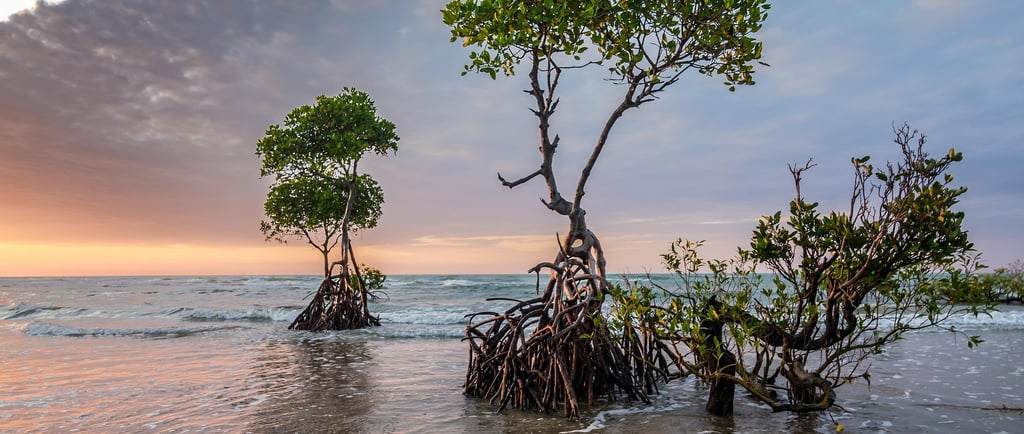The Trees That Walk on Tiptoes on Water 🌊👣The Mangrove 🌳
🌿 A follow-up story that branches from the Ecology and The Root chapters in the Biology Album. 🌱✨ This story invites children to explore one of nature’s most unusual problem-solvers. These incredible coastal trees grow where land meets sea—anchoring in salty, muddy waters with stilt-like roots that breathe, balance, and explore. 🌊👣🌳 This story bridges lessons on plant adaptations, root types, and ecosystems. It sparks wonder: “How can trees live with their feet in the ocean? Do roots always grow down… or can they grow up to breathe?” 💭🌬️🌱
BIOLOGY STORIES
6/5/20253 min read


Have you ever seen a tree walking on tiptoe? 👣🌱 Come close to the shore… where the sea kisses the land, and you might just meet one. There, where saltwater sloshes over the sand, rise the mangroves—trees that don’t mind getting their feet wet. 🌊🌳
Mangroves aren’t like ordinary trees. Their roots arch and twist above the mud like wooden stilts or tangled bridges. These are prop roots—a special kind of root that holds the tree high and steady, even when the tide rolls in. Some mangrove roots even breathe! 🌬️ They stick up out of the soggy ground like snorkels, drawing in air from above. These breathing roots are called pneumatophores (👏 pneu 👏 ma 👏 to 👏 phores), from the Greek pneuma meaning “air” and phoros meaning “carrying.”
Why so many odd roots? Because mangroves grow where few trees dare—on salty shores, muddy deltas, and brackish lagoons where land and sea meet and wrestle. And yet, they flourish! 💪🌊🌱
Mangroves are masters of survival. Their roots are the ones that sip the salty water from the sea. 🌊🧂 These brave roots don’t get to choose—saltwater is all around them! But here’s the twist: the plant doesn’t want too much salt moving up into the rest of its body. So, the mangrove has clever ways to manage it. Some mangroves block most of the salt right at the root—like a picky drinker using a filter straw. 🧂🚫🥤 But even if a little salt sneaks through, the leaves jump in to help. Their leaves have special salt glands that work like sweat pores. They push the extra salt out onto the surface of the leaf, where it dries like white crystals you can even taste! 🧂🌿👅 And when too much salt builds up, the tree might sacrifice one salty leaf—dropping it like a salt-soaked sponge to keep the rest of the tree safe. 💧🍂 It’s a smart team: the roots filter, the leaves sweat, and together, they protect the whole tree. What a salty strategy!
And their seeds? Oh, they’re just as clever! Mangrove seeds don’t wait around in the mud hoping for the perfect spot. Nope—they start growing while still hanging from their parent tree! 🌱🍼These super-prepared baby trees are called propagules (👏 pro 👏 pa 👏 gules). The name comes from the Latin word propagare, which means “to extend.” 🌱✨ Just like a helping hand stretching out to grow something new! The little -ule at the end means “a small thing”—so a propagule is a little thing that helps a plant spread and grow! 🧳🌿
🌱 When we look at a mangrove propagule, we notice a long, green part with a little brown cap at the top. The long green body is the embryonic root, also called a radicle—this is the part that will anchor the new mangrove into the soil once it finds the perfect spot! The brown cap at the top is actually the seed coat or sometimes the cotyledons.
As soon as they’re ready, they drop with a gentle plop, float across the waves like tiny green submarines. But when the tide lowers and it finds mud, the pointed root end sticks in like a dart 🎯, and the shoot (stem and leaves) start to grow upward toward the sun. 🌞🌿 It’s like the mangrove tree packs its own suitcase, kisses the baby goodbye, and says, “Off you go—find your place in the world!”
But mangroves don’t just care for themselves. These trees are guardians of the coastline. Their roots trap soil, slow waves, and hold the Earth in place like nature’s net. They protect shorelines from eroding, soften the blow of storms, and keep the waters clear for coral reefs. 🌊🛡️
Many animals find shelter in mangrove forests. Baby sharks and fish hide among the roots. Crabs, herons, and even monkeys make their homes in these swampy groves. 🐟🦀🦢 They are nurseries for young fish, crabs, shrimp, and even seahorses, food banks, and jungle gyms all in one. A whole ecosystem comes alive beneath the mangrove canopy.
Humans, too, have lived alongside mangroves for generations. In many coastal communities, people use their strong, water-resistant wood to build boats, homes, and even fishing tools. 🛶🌿 Their bark has been used to dye cloth or prepare traditional remedies. 🧵🌊 In seaside villages, children learn to fish among the tangled roots, and elders tell stories of how these trees once saved lives—slowing the force of storms and floods. But mangroves don’t just help people—they help nature, too! Their roots are like nature’s underwater nets, trapping plastic waste and floating debris, helping to keep the ocean clean. 🧺🌊🐟 In many languages, mangroves are known as “trees that walk” or “roots that breathe.” Isn’t that one unusual tree ?
💭 I wonder… 🌊 What other trees can live where land and sea meet—half in water, half on land?🦶 Are there other plants that walk on tiptoes like mangroves with stilt roots?🌱 What other seeds sprout before they even fall—just like mangrove propagules?🧂 How do other plants deal with salt? Do they spit it out too?🔍 Are there plants that grow without soil at all?
With Montessori joy,
Vanina 😊

